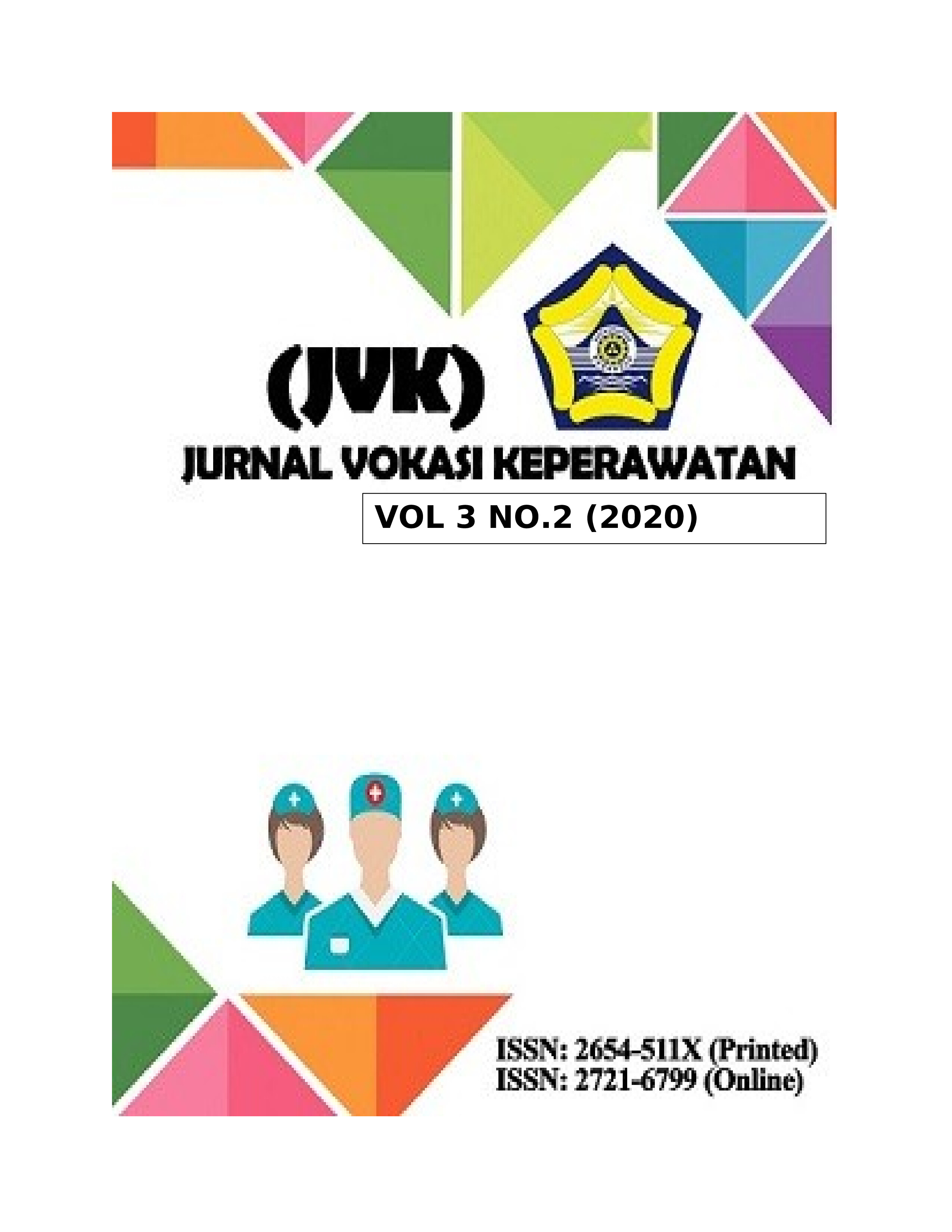Main Article Content
Abstract
Hypertension is a condition where an increase in blood pressure above normal. High prevalence of hypertension occurs in women. in Sumbar hypertension in women reaches 24%, and in Puskesmas Nanggalo reaches 7.53%. Factors of hypertension in women are obesity and stress. The purpose of this study was to determine the factors associated with the incidence of hypertension in women at the Nanggalo Padang Health Center. This research uses descriptive analytic cross sectional design. Data collection was conducted at Nanggalo Public Health Center in Padang with a sample of 57 people, with accidental sampling technique. Retrieval of data using primary data collected through questionnaires and weighing BMI and secondary data obtained from the documentation study at Padang Nanggalo Public Health Center. Data were processed with SPSS using univariate analysis of frequency distribution and bivariate chi- square test.The results of the study are known from 57 respondents 66.7% who suffer from hypertension, 78.4% respondents who are obese, 80% respondents are stressed Bivariate analysis showed that there was a relationship between. The relationship between obesity and hypertension (p= 0.024 ? 0.05). The relationship between stress and hypertension (p=0.030 ? 0.05). From the results of this study the incidence of hypertension in women is related to the use obesity and stress. Suggestions for health workers to further improve counseling about healthy eating and exercise to prevent hypertension.
Keywords
Article Details
References
- Aspiani, R. Y. (2014). Buku Ajar Asuhan Keperawatan Klien Gangguan Kardiovaskuler.Jakarta : EGC.
- Azmi,.L.(2014). Faktor- Faktor Yang Berhubungan Dengan Kejadian Hipertensi Di Wilayah Kerja Puskesmas Rumbai Pesisir.Jurnal Keperawatan (E-Journal), 5 (1), 235 242.
- Bustam, M. N. (2015). Manajemen Pengendalian Penyakit Tidak Menular. Jakarta : Rineka Cipta.
- Bybee, K. A., & L, S. (2014). Penyakit Kardiovaskuler pada Wanita. Jakarta : Erlangga
- Dinas Kesehatan Kota Padang. (2017). Profil Kesehatan Kota Padang, (45)
- Guyton & Hull. (2011). Buku Ajar Fisiologi Kedokteran.Singapura : Elsevier.
- Kolibu, F., & Kalesaran, A. (2018). Faktor-Faktor Yang Berhubungan Dengan Terjadinya Hipertensi Pada Masyarakat Desa Tempok Selatan Kecamatan Tompaso Kabupaten Minahasa. KESMAS, 7(1).
- Nieky.S . (2014). Faktor-faktor yang Berhubungan Dengan Kejadian Hipertensi Pada Wanita Usia Subur Di Puskesmas Umbulharjo I Yogyakarta Tahun 2014. Jurnal Kesehatan Masyarakat (Journal ofPublic Health), 4(2), 94–102.
- doi.org/10.12928/kesmas.v4i2.1027
- Nursalam. (2013). Penelitian Ilmu Keperawatan : Pendekatan Praktis. Jakarta : Salemba Medika
- Notoadmojo.(2012). Metodologi Penelitian Kesehatan.Jakarta : Rinkes Cipta
- Rizky, E. (2017). Hubungan Antara Stres dengan Kejadian Hipertensi pada Dewasa Awal di Dusun Bendo Desa Trimurti Srandakan Bantul Yogyakarta. Retrieved from http://elibrary.almaata.ac.id/717/1/skripsi gabung.pdf Diakses pada tanggal 28 Maret 2019
- Riskesdas. (2018). Hasil Utama Riskesdas2018.Kementrian Kesehatan Republik Indonesia, 1–100. doi.org/1 Desember 2013
- Sari, Y. N. I. (2017). Berdamai dengan Hipertensi.Jakarta : Bumi Medika.
- Supardi, S. (2013). Buku Ajar Metode Riset Keperawatan. Jakarta : Trans Info Media.
- Triyanto, E. (2014). Pelayanan Keperawatan Penderita Hipertensi Terpadu. Yogyakarta : Graha Ilmu.
- Wade, Calsrson. (2016). Mengatasi Hipertensi. Bandung: Nuansa Cendekia
- WHO. (2013). A global brief on Hyper tension World Health Day 2015.World Health Organization, 1–40
References
Aspiani, R. Y. (2014). Buku Ajar Asuhan Keperawatan Klien Gangguan Kardiovaskuler.Jakarta : EGC.
Azmi,.L.(2014). Faktor- Faktor Yang Berhubungan Dengan Kejadian Hipertensi Di Wilayah Kerja Puskesmas Rumbai Pesisir.Jurnal Keperawatan (E-Journal), 5 (1), 235 242.
Bustam, M. N. (2015). Manajemen Pengendalian Penyakit Tidak Menular. Jakarta : Rineka Cipta.
Bybee, K. A., & L, S. (2014). Penyakit Kardiovaskuler pada Wanita. Jakarta : Erlangga
Dinas Kesehatan Kota Padang. (2017). Profil Kesehatan Kota Padang, (45)
Guyton & Hull. (2011). Buku Ajar Fisiologi Kedokteran.Singapura : Elsevier.
Kolibu, F., & Kalesaran, A. (2018). Faktor-Faktor Yang Berhubungan Dengan Terjadinya Hipertensi Pada Masyarakat Desa Tempok Selatan Kecamatan Tompaso Kabupaten Minahasa. KESMAS, 7(1).
Nieky.S . (2014). Faktor-faktor yang Berhubungan Dengan Kejadian Hipertensi Pada Wanita Usia Subur Di Puskesmas Umbulharjo I Yogyakarta Tahun 2014. Jurnal Kesehatan Masyarakat (Journal ofPublic Health), 4(2), 94–102.
doi.org/10.12928/kesmas.v4i2.1027
Nursalam. (2013). Penelitian Ilmu Keperawatan : Pendekatan Praktis. Jakarta : Salemba Medika
Notoadmojo.(2012). Metodologi Penelitian Kesehatan.Jakarta : Rinkes Cipta
Rizky, E. (2017). Hubungan Antara Stres dengan Kejadian Hipertensi pada Dewasa Awal di Dusun Bendo Desa Trimurti Srandakan Bantul Yogyakarta. Retrieved from http://elibrary.almaata.ac.id/717/1/skripsi gabung.pdf Diakses pada tanggal 28 Maret 2019
Riskesdas. (2018). Hasil Utama Riskesdas2018.Kementrian Kesehatan Republik Indonesia, 1–100. doi.org/1 Desember 2013
Sari, Y. N. I. (2017). Berdamai dengan Hipertensi.Jakarta : Bumi Medika.
Supardi, S. (2013). Buku Ajar Metode Riset Keperawatan. Jakarta : Trans Info Media.
Triyanto, E. (2014). Pelayanan Keperawatan Penderita Hipertensi Terpadu. Yogyakarta : Graha Ilmu.
Wade, Calsrson. (2016). Mengatasi Hipertensi. Bandung: Nuansa Cendekia
WHO. (2013). A global brief on Hyper tension World Health Day 2015.World Health Organization, 1–40
